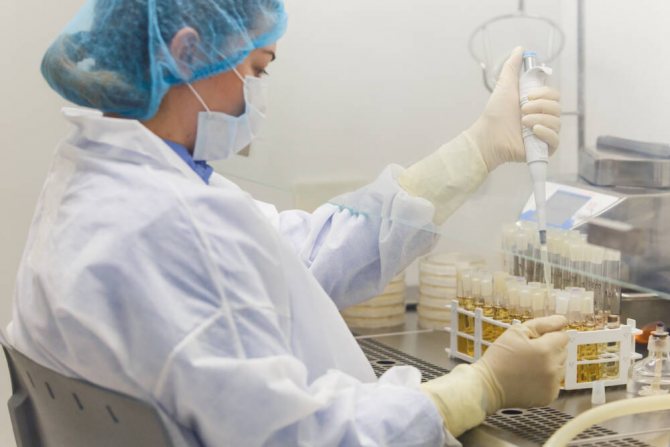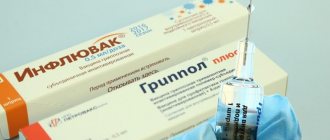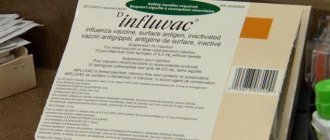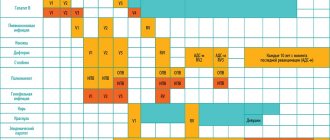The production of antibodies in the body begins approximately after a two-week interval from the moment of vaccination. For another 6 months after the flu shot, the body retains the ability to recognize the virus and destroy it, preventing it from multiplying in cells. Thanks to this, you are protected from infection throughout the autumn-winter period.
But what about 70-90% efficiency? Yes, doctors admit that the flu vaccine does not always protect against the occurrence of this particular or another viral infection (adenovirus, enterovirus, rhinovirus, etc.), but even if you get sick, the vaccine will prevent complications and ease the course of the disease.
When does vaccination usually start and end?
All doctors talk about the importance of regular flu vaccinations.
But when vaccinations are given, what is the best time to start? The influenza virus attacks in the fall, so the vaccine should be given at the end of summer - 3-4 weeks before the cold season, when weakened immunity is most vulnerable. The vaccine can be administered even in the spring, since from year to year spring becomes the leader in the incidence of influenza. The effect of the vaccination will last about a year. And next year you will need to get vaccinated again: after all, the virus is mutating and the immune system is no longer able to cope with it. We talk in more detail about the virus and protection against it in this article. In Russia, the flu vaccination season usually begins in early September. Sometimes mass vaccination starts earlier or later than this period, which is due to the complexity of the vaccine production chain. Before the drug hits the market, work is done in several directions at once: they study the incidence of influenza in the world, determine mutations in the genes of the virus, grow the virus and after that create a vaccine.
Virologists examine the blood of people who have had the flu, determine its type and strain (a unique number with information about the type, place of origin, animal carrier and year of occurrence). Epidemiologists exchange experience twice a year at scientific conferences and decide which flu strains will be most active in the coming season. They transfer this data to pharmaceutical companies that begin production of the vaccine. If scientists need more time to identify dangerous and active strains in the current season, the release of the current vaccine is delayed.
Important! Flu is a virus that spreads very quickly. Its structure includes surface proteins: hemagglutinins and neuraminidases. These proteins make up different combinations, which, moreover, are subject to mutations, as a result of which a new strain is formed every time two different viruses meet. This is why the work of virologists and epidemiologists is so important, and for the same reason it is necessary to get a flu shot every year.
In Russia, Roszdravnadzor announces the start of vaccination. Doctors advise not to wait for cold weather and the peak of colds and to get vaccinated against seasonal flu as soon as the vaccine becomes available. Therefore, sometimes the start occurs in August. But usually the optimal period for immunization is considered to be September - October, 3-4 weeks before the start of the seasonal epidemic.
The vaccination season never ends; doctors recommend vaccination both in winter and spring. This is due to the fact that in recent years, in the country and the world, the peak incidence occurred in February and even March. Therefore, if you get vaccinated later - in January-February, you can protect yourself from a flu outbreak in early spring.
Unlike vaccination season, the vaccines themselves may run out. Doctors warn: starting from January, it will be more difficult to find a vaccine in public clinics than at the start of vaccination. However, a paid clinic will most likely always have a vaccine, at any time of the year. With late vaccination, it is important to clarify the duration of the drug; as a rule, it ranges from six months to 1 year. If a vaccine only lasts six months and was developed in September, it will no longer be effective in March.
Is it possible to get vaccinated in the summer?
Source: McKinsey/Rawpixel
Vaccination in the summer, according to doctors, does not make sense. On the one hand, vaccines with a short duration will not be able to protect against possible peaks in incidence in the spring. On the other hand, it takes 5-6 months to create a vaccine and release it on the market, since pharmaceutical companies receive information about the vaccine strain from epidemiologists and only after that begin production of the vaccine. In a shorter period of time, it is impossible to grow a strain of the virus in laboratories, carry out quality control of the vaccine and conduct clinical trials.
Is it possible to get vaccinated in winter?
Yes. In the absence of the opportunity to get vaccinated earlier, doctors only welcome late immunization - in winter or even spring. It is especially important to get vaccinated for those planning a trip to the Southern Hemisphere. In these countries, the influenza virus is most active during other months, from April to September. And vaccination, even if late, is especially important for those who are most vulnerable. At risk: pregnant women, people with chronic diseases (heart and lung, asthma, diabetes), cancer patients, HIV-infected people. The vaccine gives a person lifelong immunity from the strains of the virus it contains. Therefore, the principle “better late than never” applies here.
Is there a difference in the timing of vaccinations for children, adults and the elderly?
The vaccination season begins at the same time for everyone - children, adults, and the elderly. The only difference is the choice of vaccine and its dose. Children aged 6 months to 2 years (and up to 9 years if they are receiving the vaccine for the first time) are given half the dose of influenza vaccine. The second dose is recommended after 4 weeks, as it increases the effectiveness of immunization.
Some vaccines have age restrictions. Thus, the quadrivalent vaccine, which is already available to Russians, is prohibited for use in children under 6 years of age. There are also vaccines whose instructions specify a maximum age - usually 60 years. An older person will need to choose a different vaccine.
Which vaccine should I choose? Doctors advise choosing a vaccine that contains 15 micrograms of antigens from each strain of the virus. The most effective is the quadrivalent vaccine, which protects against 2 type A viruses and 2 type B viruses. For more information about the types of influenza vaccines, as well as what they consist of and what strains they include, read the articles “Flu vaccinations in 2020- 2021” and “Flu Vaccinations”.
Virus on an industrial scale
After WHO determines the composition of influenza vaccines for the next epidemic season, samples of live viruses are created in the organization’s laboratories. In order to make these pathogens safe and suitable for further cultivation, they are mixed with a laboratory virus. The result is a hybrid virus. Inside there is a laboratory virus, but on the surface there are antigens of the pathogen against which vaccinated people should develop immunity.
“To create a flu vaccine, two key components are needed: the virus itself and chicken embryos, where it will multiply. During the production period, more than 160 thousand eggs are supplied daily,” says the general director of the enterprise, Pavel Vandyshev.

Laboratory quality control / ©Natsimbio Press Service
All embryos are carefully ovoscoped - “canned” in order to reject unsuitable ones. An egg is not suitable for propagation of the vaccine strain if it is infected, unfertilized, if the embryo is dead or if there are cracks in the shell. Suitable samples must rest in containers for 18 hours - during this time the embryos will take the correct position.
The enterprise has introduced an automated complex for the preparation and processing of biomaterials. Production capacity allows us to produce up to 250 thousand chicken embryos per day. Then the embryos are disinfected and infected - this is done on a special automatic robotic line. Each strain of the virus is injected separately into different embryos.

Inactivation of the virus in centrifuges / ©Natsimbio Press Service
This way, the live virus can be multiplied almost indefinitely, depending on the needs for the vaccine and the production capacity of the enterprise. When an industrial batch is infected and the virus develops in the embryos, specialists carry out numerous stages of quality control.
The intermediate product obtained from infected embryos contains a lot of virus, but it is still far from a vaccine. At the next stage the most difficult and interesting part begins. The goal of a vaccine is to trigger an immune response, but so that the person does not develop an infection. Therefore, live viruses must be killed and destroyed.

Conveyor shop for the production of influenza vaccines / ©Natsimbio Press Service
As a result of treatment with special chemical reagents, the virus is destroyed and completely split into parts. The finished vaccine is completely free of single live viruses. The result is an inactivated split vaccine. Next, it goes through a multi-stage purification system, including ultrafiltration, as well as sedimentation in unique high-speed centrifuges to remove all foreign impurities.
How soon will it work?
The vaccine contains a killed or very weakened virus. After its administration, the body must produce antibodies and immune cells that will protect against the severe consequences of infection with the “wild” influenza virus. For this, the immune system needs 2 weeks. The positive effect of the influenza vaccine is that it forms stable immunity to certain strains of the virus, prevents the development of severe forms of the disease, reduces the likelihood of death and contributes to the emergence of collective immunity.
What flu strains will circulate in Ukraine in the 2020/21 season?
The World Health Organization (WHO) annually provides forecasts for the epidemic season in different regions of our planet. Based on this, manufacturers change the composition of vaccines so that they most accurately meet current infection threats.
According to a new WHO forecast, 4 strains of influenza will circulate in the northern hemisphere in 2020/2021:
- type A Guangdong-Maonan (H1N1)
- type A Hong Kong (H3N2)
- type B Washington (B / Victoria lineage)
- type B Phuket (B / Yamagata lineage)
Seasonal three- and four-component vaccines are designed to protect against these particular strains of the influenza virus.
In general, current flu vaccines tend to work better against influenza B and A (H1N1) viruses, but somewhat less well against the influenza A (H3N2) strain, the CDC reports.
How often should you get vaccinated?
Doctors believe that after vaccination, immunity lasts for about a year. The beneficial effects last and support the body until the next vaccination. Therefore, there is no need to vaccinate more than once a year. It is also known about the cumulative effect of vaccines, when during the annual flu vaccination the human immune system produces a whole collection of antibodies. It is assumed that in the future this kit will be able to resist any influenza virus. But for now this issue requires further study and additional experiments.
Contraindications
Contraindications can be temporary or absolute. The following are subject to an absolute ban on influenza vaccination:
- People allergic to egg whites (many influenza vaccines use chicken embryos). In Russia, all available vaccines contain chicken protein. However, this allergy will not be a problem in countries where there are vaccines created without the participation of such proteins.
- People with severe reactions and post-vaccination complications after receiving previous doses of the vaccine. This is a fairly rare occurrence, however, if there are negative reactions to the first dose of the vaccine, this drug is not recommended for further use.
Temporary contraindications include cases of exacerbation of any chronic disease or infection. For example, with acute respiratory viral infections and intestinal diseases, you need to wait until the temperature drops; for seasonal allergies - when it goes into remission; for hypertension - stabilize blood pressure. After this, the “green light” is turned on for vaccination: you can and should go to the clinic for an annual vaccination.
Figure 1. Usually, the current dates of use are written on the vaccine package.
Coronavirus infection is not a contraindication to vaccination. As with any other infection, you need to wait for recovery.
For more information about contraindications and the compatibility of flu vaccination with coronavirus, read the articles “Flu Vaccination: Contraindications” and “What you need to know about flu vaccination in the era of COVID-19.”
We also recommend that you familiarize yourself with the episode of the program “Science Against”, with a physician of the highest category, toxicologist, popularizer of science Alexey Vodovozov.
Pros and cons of the flu shot
The benefits of vaccination are obvious:
- Vaccination leads to the development of specific immunity that protects the body from influenza infection. It significantly reduces the risk of illness, and if a vaccinated person does get sick, he or she tolerates the flu more easily, without complications, and recovers faster.
- Modern vaccines include not one, but several strains of pathogens, which are announced annually by WHO. This organization conducts large-scale research and identifies those strains that are most likely to spread in a particular area.
However, there are also disadvantages to using the vaccine:
- Vaccination does not guarantee absolute protection against the disease. No drug can provide such a guarantee. In addition, the WHO may make a mistake in its forecasts and another strain of influenza that is not included in the vaccine will spread.
- The vaccine lasts for about a year. By the next season, influenza viruses will undergo many mutations, and antibodies will not “recognize” them.
- Vaccination is not suitable for everyone. Thus, vaccination cannot be done if a person is already sick or has worsened chronic diseases. These are temporary contraindications: vaccination is carried out after recovery. An absolute contraindication is an allergy to chicken protein, since the viruses for the vaccine are grown on chicken embryos.
Where and how to do it
You can get vaccinated free of charge at local clinics, kindergartens, schools, universities and colleges. You need to have your passport and compulsory medical insurance policy with you. The general practitioner will check for any contraindications and refer you for vaccination. It is advisable to spend the next 15–30 minutes after vaccination close to the office in case of immediate post-vaccination reactions. In many Russian cities there are mobile points where you can also get a flu shot. In the end, you can sign up for a paid clinic.
It is important to tell your doctor if you have chronic diseases or worsening infections. You should not come with a fever, another infectious disease, or an exacerbation of seasonal allergies: these are obvious contraindications to vaccination, albeit temporary. You need to wait for recovery or remission.











